Life As a Food Server
Career Description Serve food to individuals outside of a restaurant environment, such as in hotel rooms, hospital rooms, residential care facilities, or cars.
Daily Life Of a Food Server
- Carry food, silverware, or linen on trays or use carts to carry trays.
- Clean or sterilize dishes, kitchen utensils, equipment, or facilities.
- Prepare food items, such as sandwiches, salads, soups, or beverages.
- Monitor food preparation or serving techniques to ensure that proper procedures are followed.
- Monitor food distribution, ensuring that meals are delivered to the correct recipients and that guidelines, such as those for special diets, are followed.
- Take food orders and relay orders to kitchens or serving counters so they can be filled.
Featured schools near , edit
Food Server Needed Skills
These are the skills Food Servers say are the most useful in their careers:
Monitoring: Monitoring/Assessing performance of yourself, other individuals, or organizations to make improvements or take corrective action.
Service Orientation: Actively looking for ways to help people.
Active Listening: Giving full attention to what other people are saying, taking time to understand the points being made, asking questions as appropriate, and not interrupting at inappropriate times.
Speaking: Talking to others to convey information effectively.
Social Perceptiveness: Being aware of others’ reactions and understanding why they react as they do.
Coordination: Adjusting actions in relation to others’ actions.
Related Job Titles
- Wait Staff
- Food Service Tray Attendant
- Diet Aid
- Room Server
- Room Service Food Server
Job Outlook for Food Servers
There were about 263,800 jobs for Food Server in 2016 (in the United States). New jobs are being produced at a rate of 10.2% which is above the national average. The Bureau of Labor Statistics predicts 26,900 new jobs for Food Server by 2026. Due to new job openings and attrition, there will be an average of 43,100 job openings in this field each year.
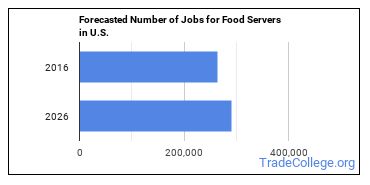
The states with the most job growth for Food Server are Utah, Arizona, and Idaho. Watch out if you plan on working in Wyoming, District of Columbia, or Connecticut. These states have the worst job growth for this type of profession.
Average Food Servers Salary
The salary for Food Servers ranges between about $18,030 and $35,150 a year.
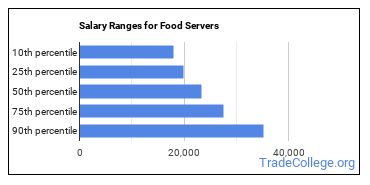
Food Servers who work in Hawaii, New York, or District of Columbia, make the highest salaries.
How much do Food Servers make in each U.S. state?
| State | Annual Mean Salary |
|---|---|
| Alabama | $21,550 |
| Alaska | $29,780 |
| Arizona | $27,320 |
| Arkansas | $20,560 |
| California | $30,350 |
| Colorado | $26,730 |
| Connecticut | $28,690 |
| Delaware | $24,700 |
| District of Columbia | $32,740 |
| Florida | $22,570 |
| Georgia | $22,020 |
| Hawaii | $38,480 |
| Idaho | $23,740 |
| Illinois | $24,450 |
| Indiana | $23,050 |
| Iowa | $23,870 |
| Kansas | $20,390 |
| Kentucky | $22,370 |
| Louisiana | $20,860 |
| Maine | $24,230 |
| Maryland | $24,730 |
| Massachusetts | $29,210 |
| Michigan | $25,220 |
| Minnesota | $27,660 |
| Mississippi | $19,330 |
| Missouri | $22,120 |
| Montana | $22,340 |
| Nebraska | $23,330 |
| Nevada | $25,570 |
| New Hampshire | $23,530 |
| New Jersey | $25,190 |
| New Mexico | $20,530 |
| New York | $32,500 |
| North Carolina | $21,180 |
| North Dakota | $27,500 |
| Ohio | $22,370 |
| Oklahoma | $21,450 |
| Oregon | $27,380 |
| Pennsylvania | $23,250 |
| Rhode Island | $25,880 |
| South Carolina | $21,750 |
| South Dakota | $26,930 |
| Tennessee | $21,830 |
| Texas | $21,170 |
| Utah | $24,950 |
| Vermont | $30,970 |
| Virginia | $22,210 |
| Washington | $27,040 |
| West Virginia | $22,190 |
| Wisconsin | $22,160 |
| Wyoming | $22,410 |
What Tools do Food Servers Use?
Although they’re not necessarily needed for all jobs, the following technologies are used by many Food Servers:
- Microsoft Office
- Microsoft Windows
- Point of sale POS software
- CBORD Nutrition Service Suite
How to Become a Food Server
Are there Food Servers education requirements?
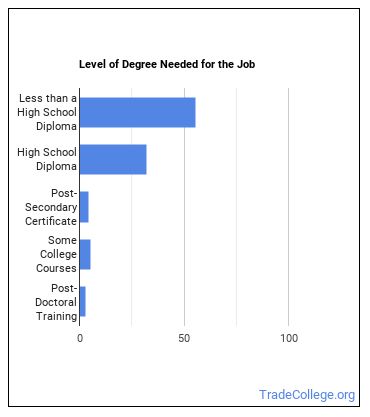
How many years of work experience do I need?
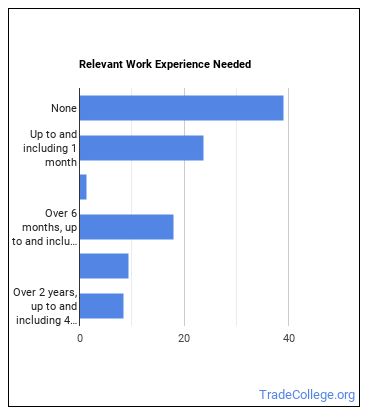
Where Food Servers Are Employed
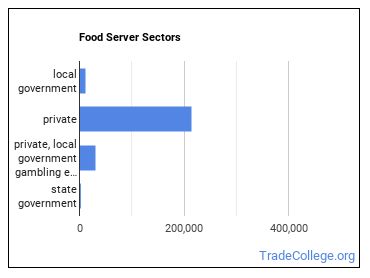
The table below shows the approximate number of Food Servers employed by various industries.
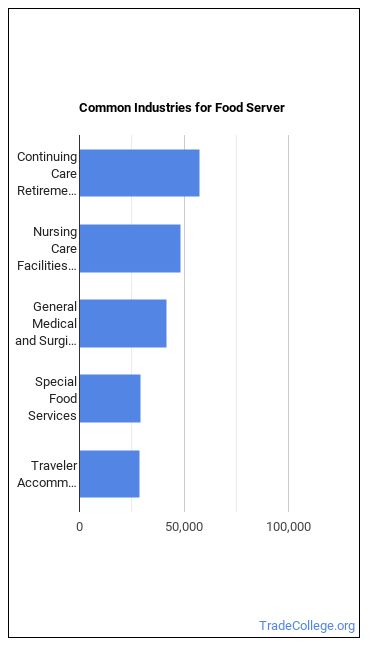
Related Careers
Those who work as a Food Server sometimes switch careers to one of these choices:
References:
More about our data sources and methodologies.
Featured Schools
 Request Info
Request Info
|
Southern New Hampshire University You have goals. Southern New Hampshire University can help you get there. Whether you need a bachelor's degree to get into a career or want a master's degree to move up in your current career, SNHU has an online program for you. Find your degree from over 200 online programs. Learn More > |
